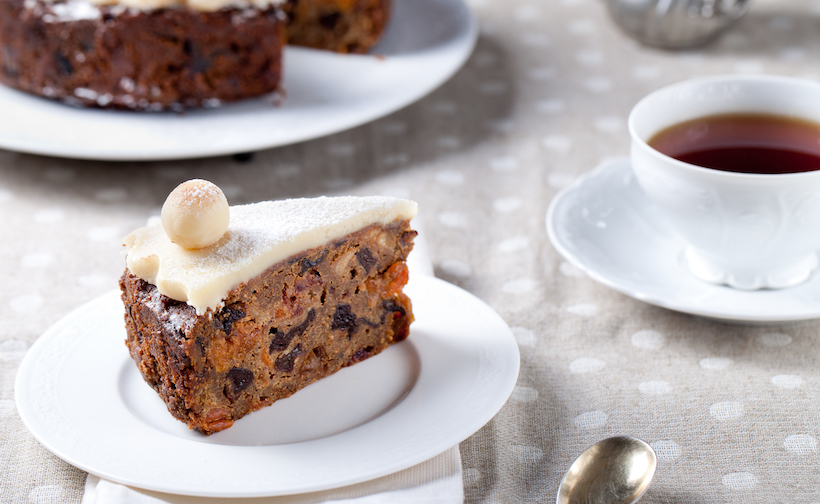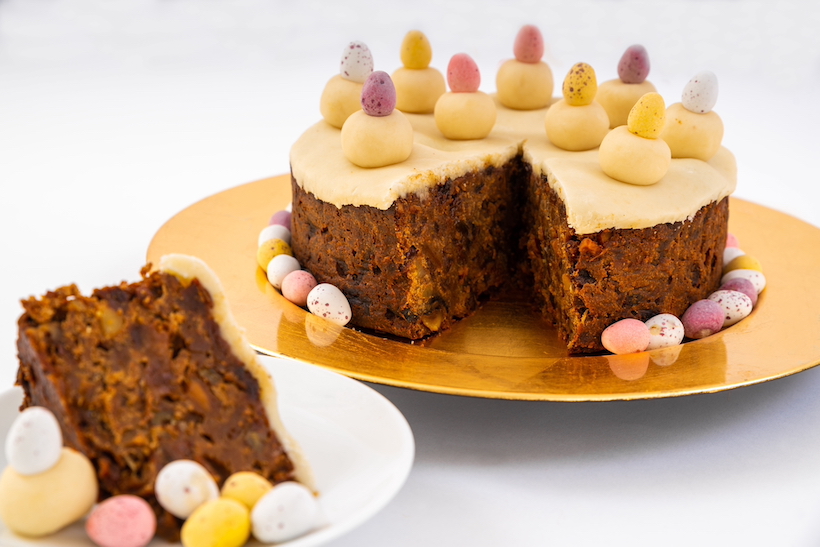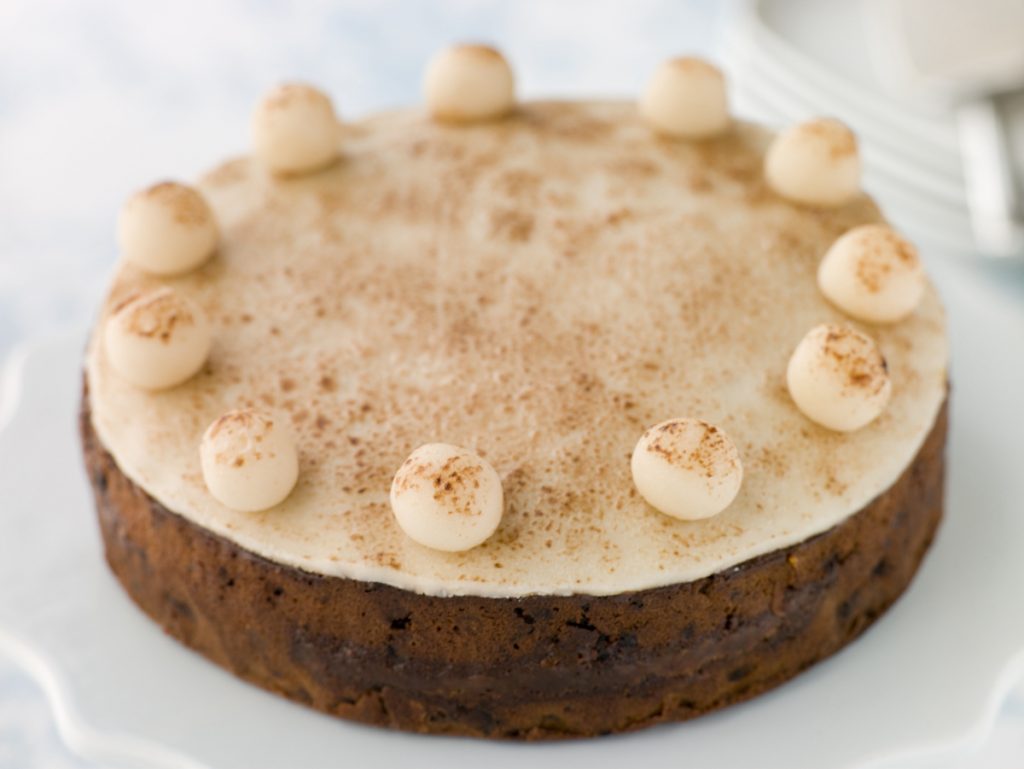The history of simnel cake reaches back to medieval times but the details regarding its true origin remain lost to the Dark Ages' historiographical abyss. As a result, the venerable simnel cake has carried with it countless myths and legends down through the centuries.
(And yes, it means I'll have to make some leaps of faith.)
Join me as I attempt to unravel the fabled mysteries of simnel cake, discuss its known history, and analyze the evolution of simnel cake batter and baking procedures.
The modern simnel cake represents centuries of recipe adaptations and improvements. Let's go over the typical ingredients, symbolism, and geographical variants of the simnel cake.

Simnel cake is a light fruitcake that many observant Christians enjoy on Easter Sunday (especially in the British Isles). In pre-modern times, the dessert traditionally fed homes on Lent's 4th Sunday.
The simnel cake's distinguishing characteristics include a middle and top layer of marzipan or plain crushed almond and eleven marzipan balls or eggs serving as decorations.
Simnel cake differentiates itself from rich fruitcake in a few ways. For one, simnel cake does not typically include alcohol – although some bakers do add brandy. Also, the recipe for simnel cake does not require the same maturation process as fruitcake recipes do.
Holiday revelers can enjoy the lighter simnel cake immediately upon completing baking and decorating.
The ingredients for a typical simnel cake include:
Simnel cakes varies in size, shape, and ingredients, primarily on a town-by-town, geographical basis. With deep roots in British culture, the simnel cakes you find in Gloucestershire and Worcestershire will look and taste a little different.
What we (or at least me, as an American observer) now know as simnel cakes most closely resemble those made in Bury. Let's go over a few varieties:
All of these different takes on the simnel cake get served on Easter Sunday. However, in the past, most Englishmen enjoyed this yummy dessert on the 4th Sunday of Lent, known as Mothering Sunday.
Mothering Sunday marked the halfway point and a day of relief from fasting. You see, our medieval forebears could not consume lacticinia (dairy products) during the rest of Lent – which rules out many baked goods on other days.
Thus, Mothering Sunday represented a day of celebration and a temporary breaking of the fast, allowing observers to eat simnel cake, which contained butter and eggs. Contrast it with Pancake Tuesday, a tradition to use up eggs and milk before Lent begins.
The religious connections to the simnel cake expanded into its decorations.
Traditionally, the top of the cake includes 11 (or sometimes 12) marzipan balls to represent the 12 apostles – that is, 12 minus Judas. And, the ball count is just scratching the surface of the hidden meanings and forgotten past of the storied simnel cake.
Let's take a few more bites and see what we can discover.

From its Latin origins to its precursor pastries to its debunked origin myths, the simnel cake has captured the imaginations of historians, Christians, bakers, cake-lovers, you, and me for centuries.
While the original meaning of the word "simnel" remains shrouded with the lost history of the rest of the Dark Ages, the first known mention of it appears in a statute of 51 Henry III (1266-7), which describes "bread made into a simnel."
Nathaniel Bailey's An Universal Etymological English Dictionary (1721) calls simnel "a Cake or Bun made of fine Flower" and suggests its Latin root as "simila."
That's a word we can use. Simila translates to "fine" and serves as the Latin root for the word "semolina."
In Gerald Massey's A Book of Beginnings, he points out that the simnel cake also went by the name of "mothering-cake." He also states that Johannes de Garlandia (c. 1190-1270) equated the simnel cake with the placentae cake.
Of course, all of this ties in nicely with Easter, birth and rebirth, the Virgin Mary – and Mothering Sunday.
Indeed, some of the earliest mentions of the singular simnel undoubtedly refer to the modern simnel cake's precursors. Most likely, sometimes simnel is the "bun" referred to in Bailey's definition.
We can infer that simnel bread was simple from its description in Ezekiel 16:19 of the Coverdale Bible, which reads, "My meate which I gaue the, as symnels, oyle & hony: (to fede the withall) that hast thou set before them, for a swete sauoure. And this came also to passe, saieth the LORDE God:"
Okay, a 'y' – but you see the similarity.
Given the basic condiments accompanying the simnel, we can surmise that the bread described therein did not have the candied peel and marzipan balls that are the hallmarks of simnel cake today.
Myles Coverdale may have laundered an anachronistic English food item into pre-Christian Ezekiel. But let me make another leap. One similarity between simnels and another popular Jewish snack exists: bakers boil and then bake both simnels and bagels.
The history of Mothering Sunday in England began in 17th-century Worcestershire and Gloucestershire. Lower-class servants and middle-class apprentices would return home on the 4th Sunday of Lent to check on their parents. This return represents an adaptation of an earlier tradition of visiting one's "mother" church, cathedral, or basilica on that day.
In the 1600s, when food was scarce and a boy or girl's aging parents were fasting, a calorie-rich simnel cake, with all of the butter and eggs prohibited the previous four weeks, served as a welcome boost to the health of England's poor.
Because the strict observance of liturgical minutiae waned over the following centuries, the simnel cake lost its association with the 4th Sunday of Lent and now often shows up at the dinner table on Easter.
However, in remembrance of the original Mothering Sunday, the U.K. now celebrates Mother's Day in March, and simnel cakes have regained popularity on this day.
Because of its long history, the simnel cake serves as the subject of several myths and legends.
In an 1838 edition of the Wiltshire Independent, a poem called "The Sim-Nell; Or, The Wiltshire Cake" tells the story of Simon and Nell. In it, Simon and his wife Nell argue how to bake the cake best. One wants to boil it, and the other wishes to bake it. In the end, they compromise and decide to do both.
Another myth has Lambert Simnel at its heart. Lambert Simnel is best known as the pretender to the throne during the reign of Henry VII. Dublin's people watched the coronation of Lambert at Christ Church Cathedral when he had only yet attained the age of ten.
The legend continues with Henry VII sparing Lambert's life and relegating him to the Royal Kitchen, where Lambert devised the recipe for simnel cakes.
Of course, that myth isn't true either. The first mention of simnel cakes predates Lambert Simnel's birth by over two centuries.

Mothering Sunday began as a day to visit one's mother church, meaning the church where one received the sacrament of Baptism.
Parishioners would embark on this pilgrimage every year and arrive at their mother churches on Lent's 4th Sunday. Over time, the meaning changed, and citizens would visit their parents on Mothering Day instead.
Although historical accounts of marzipan predate those of simnel cakes, the addition of this confection occurred in the 1900s. Before the use of marzipan, most simnel cakes bore an egg-based glaze on the outside.
Simnel cake differs from fruitcake in several ways.
One of the main differences involves the waiting period after baking a fruitcake. Fruitcakes must mature over time after baking. Simnel cakes become edible immediately. Also, whereas most fruitcakes contain alcohol, most simnel cakes do not. And, although dense, simnel cakes are less so than fruitcakes.
So whether simnel cake is an Easter or Mother's Day tradition for you – or if this is the first time you're ever reading about it – you have to admit it's a fascinating baked good. The next time you bite into that marzipan-enhanced fruitcake, I hope you think back to this post – oh, and also, I hope you enjoy!